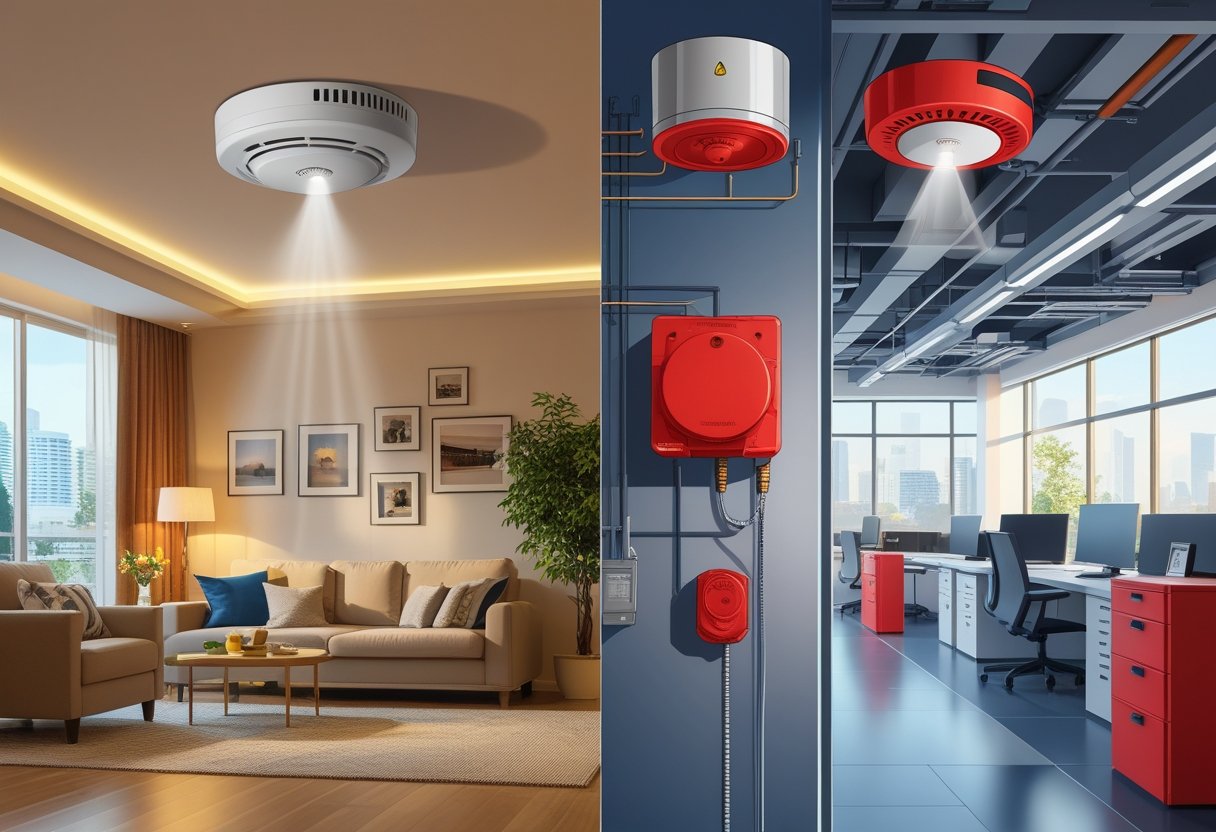When it comes to protecting your property, understanding the difference between residential and commercial fire alarms is essential. Residential fire alarms focus on protecting individual households with straightforward systems, while commercial fire alarms must adhere to strict regulations and integrate more complex safety measures. This distinction impacts not only the design of the systems but also their installation and monitoring requirements.
If you live in the greater Houston area, ensuring you have the right fire alarm system tailored to your needs is vital for safety. Residential fire alarms prioritize immediate alerts for personal spaces, while commercial fire alarms are engineered to cover larger areas and accommodate more sophisticated fire detection technologies. This makes choosing the appropriate system crucial for safeguarding your home or business from potential fire hazards.
By understanding these differences, you can make an informed decision that ensures compliance with local safety standards and enhances the protection of your assets. Whether you're a homeowner or a business owner, knowing what distinguishes these fire alarms will guide you in selecting the best safety solution for your needs.
Core Differences Between Residential and Commercial Fire Alarms
Understanding the distinctions between residential and commercial fire alarms is essential for ensuring safety and compliance. Key differences include detection coverage, technology used, and power reliability.
Detection Coverage and System Complexity
Residential fire alarms typically focus on covering single units or homes efficiently. These systems often utilize simpler configurations, with devices strategically placed in key areas like bedrooms and hallways.
In contrast, commercial fire alarm systems are designed for broader and more complex coverage. They must account for larger spaces, multiple rooms, and varied layouts. Each commercial smoke alarm can incorporate multiple sensors to cover extensive areas, ensuring compliance with fire safety regulations. This complexity allows for integration into larger fire detection systems that can communicate alarms across a building.
Fire Detection Technologies Used
Residential smoke detectors often depend on ionization or photoelectric technology. Ionization detectors are more responsive to flaming fires, while photoelectric devices excel at detecting smoldering fires. You typically find these devices in homes due to their affordability and ease of installation.
Commercial fire detection systems employ advanced technologies such as heat sensors and multi-criteria detectors. These devices can identify smoke, heat, and other indicators of fire, improving response times significantly. Furthermore, commercial smoke alarms often integrate with building management systems to provide real-time alerts and monitoring. This capability is critical, especially in bustling environments like offices and retail spaces.
Power Sources and Backup Reliability
In residential settings, fire alarms usually rely on batteries or AC power connections. Battery backup is essential to maintain functionality during power outages. Many homeowners opt for battery-operated units for ease of installation, though they require regular maintenance.
Commercial fire alarms typically use dual power sources for added security. These systems often combine AC power with battery backup, ensuring continual operation regardless of external conditions. This redundancy is vital in commercial spaces where downtime can lead to dangerous situations. Additionally, commercial systems often include generator power options, ensuring full operation even during prolonged outages.
Monitoring, Alerting, and Integration Features
Understanding the specific features of fire alarm systems is crucial for effective fire safety. The following sections detail the essential elements of monitoring, alerting, and integrations that differentiate residential and commercial fire alarm systems.
24/7 Monitoring and Emergency Response
In commercial properties, 24/7 monitoring is vital for ensuring a rapid emergency response. Fire alarm systems often connect to a monitoring center that responds immediately to alerts. This service is particularly beneficial as it provides real-time notifications to emergency services in case of a fire, minimizing response times and potential damage.
For residential systems, while monitoring is available, it is less common. Your home may still benefit from it, especially if you are frequently away. Either way, knowing that professionals monitor your premises continuously can enhance your peace of mind.
Alarm Integration With Sprinkler Systems
Alarm systems can integrate seamlessly with sprinkler systems to create a comprehensive fire protection system. This setup ensures that when a fire alarm is triggered, the sprinklers activate automatically, controlling the fire's spread swiftly.
In commercial spaces, such integration is critical. It helps to reduce damage and potential losses by managing fires effectively. In residential settings, while sprinklers are less common, those that exist can similarly benefit from being linked to alarms, providing enhanced safety.
Automatic vs. Manual Alerts
Fire alarm systems utilize both automatic and manual alerts to ensure safety. Automatic alerts are triggered by smoke, heat, or fire detection systems. They provide immediate alerts without requiring any actions from occupants.
Manual call points, usually found in commercial environments, allow individuals to trigger alarms in case of an emergency. This blend of automation and manual activation enhances responsiveness. In residential settings, automatic alerts are typically preferred, as they ensure alerts even when residents may not be aware of the danger.
Regulatory Compliance and Maintenance Requirements
In managing fire safety, understanding regulatory compliance and maintenance requirements is crucial. The obligations differ substantially between residential and commercial fire alarm systems, particularly in their adherence to codes and the necessity of professional servicing.
Code Compliance for Commercial Buildings
Commercial buildings must adhere to strict regulations such as NFPA 72 standards. These standards specify installation and operational requirements for fire alarms, ensuring they are effective in protecting occupants.
A fire risk assessment is often mandatory to determine the specific fire hazards within the building. These assessments influence the design and implementation of fire detection systems, ensuring appropriate coverage is provided.
You should also be aware of local and state regulations, as they can impose additional requirements for commercial properties. Compliance with these codes is not just about safety; it can also affect insurance premiums and liabilities.
Inspection, Testing, and Professional Servicing
Commercial fire alarm systems require regular inspections and testing as part of compliance protocols. It is recommended that you arrange for professional servicing at least 2-3 times per year. This ensures that the system functions correctly and meets all regulatory standards.
During inspections, technicians will examine components such as smoke detectors, alarms, and pulling stations, verifying their operation. They will also conduct tests to ensure the system responds effectively in emergency scenarios. Accurate documentation of these inspections is essential for compliance purposes.
Regular servicing not only helps with adherence to regulations but also reinforces the overall safety of your commercial environment.
Maintenance for Residential Alarms
In contrast, residential fire alarms have less stringent maintenance requirements. Typically, homeowners should test their alarms monthly and replace batteries at least once a year.
It's also advisable to replace smoke alarms every 8-10 years, as their effectiveness can diminish over time. For significant home renovations, you may also want to consider a fire risk assessment to ensure your alarm system remains effective in its environment.
Homeowners are encouraged to keep records of maintenance activities and tests, although not as formally mandated as for commercial properties. This practice enhances safety and provides peace of mind.
Design Considerations and Risk Assessment
Designing fire alarm systems requires a tailored approach that considers the unique characteristics of each building and its intended use. Proper assessment of fire risk and coverage needs is crucial for ensuring the safety of occupants and protecting property.
System Design According to Building Type
Different building types necessitate distinct fire alarm designs. For residential properties, simplicity is key. You need systems that are effective yet easy to operate, often utilizing smoke detectors and basic alert mechanisms.
In contrast, commercial properties require more complex systems. They typically implement advanced technologies, such as manual call points and integrated fire protection systems. This complexity ensures compliance with stringent safety regulations. Planning should include reviewing building occupancy, layout, and purpose to create a customized alarm strategy.
Assessing Fire Risk and Coverage Needs
A thorough fire risk assessment is essential for determining the specific needs of your property. This assessment focuses on identifying potential hazards and evaluating existing fire protection measures.
Factors to consider include:
- Occupancy levels: How many people will be present at any time?
- Material flammability: What types of materials are stored or used within the building?
- Building design: Are there areas that are difficult to access or see?
Based on this analysis, you can determine the necessary coverage points for detectors and alarms. Regular assessments will help adapt your fire protection system as usage and occupancy change. This proactive approach can significantly reduce fire risks in your establishment.
Types and Components of Fire Alarm Systems
Understanding the types and components of fire alarm systems is essential for effective safety management. Notably, smoke detectors and heat sensors serve different detection needs, while sprinklers and manual call points enhance the system's effectiveness.
Smoke Detectors vs. Heat Sensors
Smoke detectors are designed to identify smoke particles, signaling potential fires early. They come in two main types: ionization and photoelectric. Ionization detectors are more sensitive to fast-flaming fires, while photoelectric types excel in detecting smoldering fires.
Heat sensors, on the other hand, respond to changes in temperature. They are less likely to produce false alarms since they only trigger when a specific temperature is reached or when there's a rapid increase in heat.
Choosing the right detectors depends on the location and specific fire risks in your building. In greater Houston, consider the environment and typical hazards when selecting between these devices for your fire detection system.
Role of Sprinklers and Additional Devices
Sprinkler systems significantly enhance fire safety by automatically discharging water when a fire is detected. They work in tandem with fire alarms to mitigate damage and contain fires until emergency responders arrive. Different systems, such as wet, dry, and pre-action sprinklers, cater to various building types and needs.
In addition to sprinklers, other devices, such as occupant notification systems and emergency lighting, are critical. These systems help ensure that occupants are alerted and can evacuate safely during a fire emergency.
For optimal safety in your property, ensure these devices are integrated into your fire alarm systems, especially for commercial settings in the Houston area where regulations may vary.
Manual Call Point Placement
Manual call points (MCPs) provide an essential means for occupants to alert others in case of a fire. These devices should be easily accessible and strategically placed throughout your building.
Position MCPs near exits and high-traffic areas where people can quickly reach them during an emergency. Ensure they are visible and well-marked.
In the greater Houston area, familiarizing your staff and occupants with the location of these call points can significantly improve response times in a fire emergency, combining personal initiative with the automated functions of your fire alarm systems.
Frequently Asked Questions
Understanding the distinctions between residential and commercial fire alarms can help you make informed decisions. This section addresses common inquiries about functionality, requirements, equipment, installation, maintenance, and regulations that apply to both settings.
How are fire detection systems different in homes compared to business premises?
Fire detection systems in homes typically use basic smoke detectors that trigger alerts when smoke is detected. In contrast, business premises often require more sophisticated systems that incorporate smoke detectors, heat sensors, and flame detectors, allowing for quicker responses to potential fires.
What are the specific requirements for commercial fire alarms versus those in residential settings?
Commercial fire alarms must meet stricter regulations and codes, ensuring reliability for larger spaces and higher occupancy. These systems often include integrated features such as sprinkler systems and more advanced notification systems to ensure the safety of numerous occupants.
Can residential fire alarms be used in commercial buildings, or is specialized equipment necessary?
While you might consider using residential fire alarms in commercial settings, specialized equipment is highly recommended. Commercial fire alarms are designed to handle the complexities and requirements of business environments, offering enhanced detection and notification capabilities.
Are there differences in the installation process of fire alarms for commercial and residential buildings?
Yes, the installation process varies significantly. Residential fire alarms are generally straightforward to install, while commercial systems require a more extensive setup that may include professional evaluation of layout, wiring, and adherence to specific building codes.
How does the maintenance and monitoring of fire alarms vary between residential and commercial properties?
Maintenance for commercial fire alarms is more rigorous, often requiring regular inspections by certified professionals. In contrast, residential systems may only need occasional checks by homeowners to ensure functionality.
In terms of regulations and codes, how do fire alarm systems in commercial buildings differ from those in residential homes?
Commercial buildings must comply with stricter codes and regulations regarding fire safety. These guidelines include specific installation requirements, regular inspections, and the integration of advanced safety features in commercial systems, ensuring enhanced protection for a larger number of occupants.
.svg)



.svg)


.svg)



